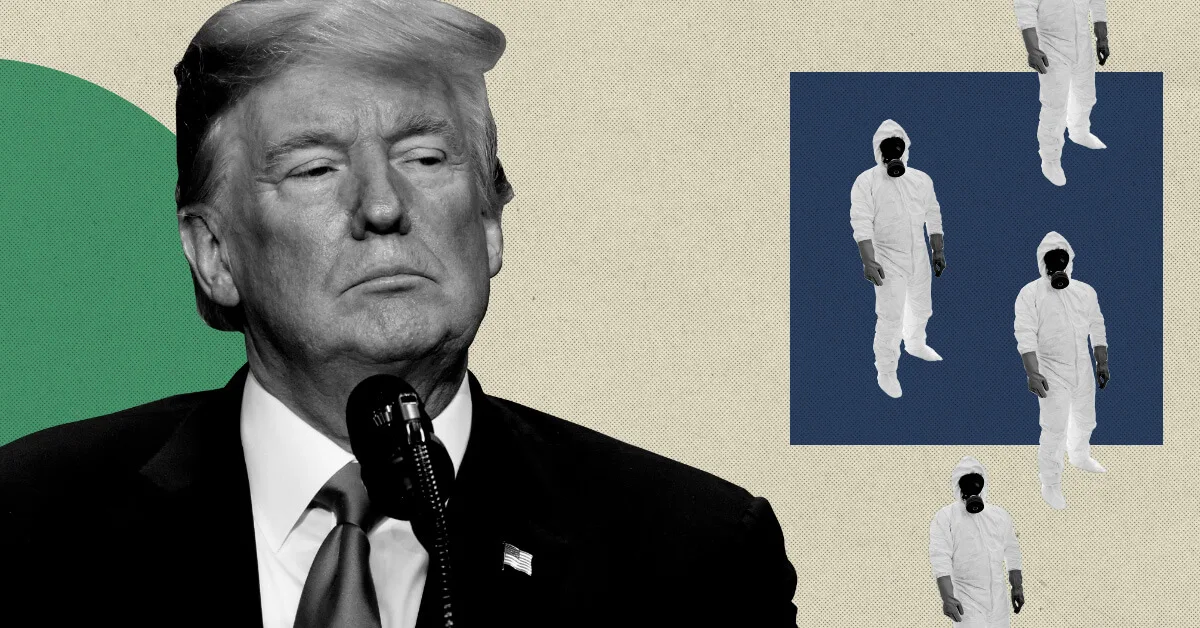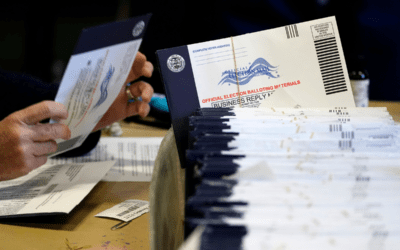
Image via Tania Lili for COURIER
States and cities have asked the federal government to send supplies for weeks, but the federal government’s response thus far has been haphazard and at times, dismissive.
A “medical warzone” is what one New York City doctor called it. “I feel like we’re all just being sent to slaughter,” said a nurse in the Bronx. “Every single person in the healthcare system is at risk,” added an Indiana doctor.
In recent days, the shortage of personal protective equipment (PPE), such as N95 masks, surgical masks, gowns, and gloves, has become national news, as an increasing number of frontline doctors and nurses speak out about the dire shortages in their hospitals and share stories of having to reuse supplies intended for one-time-only use.
States and cities have asked the federal government to send supplies for weeks, but the federal government’s response thus far has been haphazard and at times, dismissive.
“Try getting it yourselves,” Trump told the nation’s governors on March 16.
Trump has sparred with the Democratic governors of New York, Illinois, and Michigan for not being nice enough to him. Gov. Gretchen Whitmer of Michigan said Friday that the federal government may even be telling vendors not to send supplies to Michigan.
“When the federal government told us that we needed to go it ourselves, we started procuring every item we could get our hands on,” Whitmer said Friday on WWJ 950AM. “What I’ve gotten back is that vendors with whom we had contracts are now being told not to send stuff here to Michigan. It’s really concerning.”
RELATED: Trump’s Personal Grudge With Whitmer May Have Led To Supply Slowdown To State
New York, meanwhile, received only 400 of the 30,000 ventilators Gov. Andrew Cuomo said the state needs. “FEMA says, ‘we’re sending 400 ventilators.’ Really? What am I going to do with 400 ventilators, when I need 30,000?” Cuomo said at a news conference last week.
Trump later announced the government would send another 4,000 ventilators from the federal stockpile, but also downplayed New York’s need for ventilators during a Thursday interview with Fox News’ Sean Hannity.
“I have a feeling that a lot of the numbers that are being said in some areas are just bigger than they’re going to be,” Trump said. “I don’t believe you need 40,000 or 30,000 ventilators.”
Nearly 1,000 people have died of COVID-19 in New York State, as of Monday morning.
Other states, such as California, Colorado, Massachusetts, and Maine, have also found themselves receiving just a fraction of the PPE they asked for, and some of the supplies aren’t even functioning. Gov. Gavin Newsom of California said Saturday said the federal government sent Los Angeles County 170 ventilators that were “not working,” but noted that a Silicon Valley company would step up to fix the equipment.
While most states have received minimal supplies in piecemeal fashion, there is one state that has received everything it has asked for from the federal stockpile: Florida.
The state submitted a request on March 11 for 430,000 surgical masks, 180,000 N95 masks, 82,000 face shields, and 238,000 gloves, and received a shipment with everything three days later, the Washington Post reports. Florida received another shipment with the same quantity of supplies three days later and is awaiting a third, according to the Post. Florida, of course, has been ground zero for Trump’s re-election campaign. It’s where he officially launched his re-election campaign in 2019; no state may be more critical for his chances at a second term than Florida.
“There is no way he wins reelection without it,” Michael Steel, who advised former Florida governor Jeb Bush’s 2016 presidential campaign, told the Post in November.
This would not be the first time during the coronavirus crisis that Trump’s decision-making was politically motivated. Trump initially declined to pursue more aggressive testing for the disease out of fear that more positive cases would hurt his bid for re-election.
While Trump does not directly oversee the federal stockpile, his administration does. Control of the federal stockpile currently rests with the Federal Emergency Management Agency, which inherited control of the stockpile a week ago from the Department of Health and Human Services. The stockpile is already being stretched thin, as it was never intended for a crisis of this scale.
“The response contains enough for multiple emergencies,” Richard Besser, a former acting director of the Centers for Disease Control and Prevention, told the Washington Post. “Multiple does not mean 50 states plus territories and, within every state, every locality.”

But at least one Trump administration official saw the shortage coming. On Feb. 5, Health and Human Services Secretary Alex Azar asked the Office of Management and Budget for $2 billion to replenish the depleted federal stockpile, also known as the Strategic National Stockpile. By the time the White House sent its supplementary budget to Congress, that number had been slashed by 75%, to $500 million. Azar’s colleagues in HHS had also previously spent over a year arguing with White House budget officials over money to buy more stockpile supplies.
HHS officials weren’t the only ones sounding the alarms. A few weeks later, another high-ranking federal official was warning that the United States did not have enough personal protective equipment for medical workers, such as N95 masks, surgical masks, gowns, and gloves.
The warning, issued via an email chain and first reported by Kaiser Health News, was sent to senior officials in the Department of Veterans Affairs, the State Department, the Department of Homeland Security and the Department of Health and Human Services, as well as outside academics and state health officials.
“We should plan assuming we won’t have enough PPE — so need to change the battlefield and how we envision or even define the front lines,” Dr. Carter Mecher, a physician and senior medical adviser at the Department of Veterans Affairs, wrote on Feb. 25.
Mecher’s warning came one day after President Trump reassured the American public that the coronavirus was “very much under control” and two days before Trump publicly said the U.S. was “totally prepared” to deal with the disease.
These warnings underscore a grim fact about the PPE shortage: the government should have seen it coming.
“Every serious look at US pandemic readiness and global pandemic readiness has identified PPE shortages as a major issue,” Jeremy Konyndyk, senior policy fellow at the Center for Global Development, told Vox. “This is a known issue. We’ve seen it before.”
The shortage has forced doctors, nurses, and other healthcare workers to ration supplies and puts them at greater risk of getting sick and dying. Already, two New York City nurses have died of the coronavirus. The shortage of ventilators means doctors may have to choose which patients to try and save and which to let die.
RELATED: The Grim Calculations Hospitals Will Have to Make During Coronavirus
States and cities are scrambling to obtain PPE and ventilators and the federal government is finally stepping up, at least a little. President Donald Trump recently activated the Defense Production Act, a law that allows the government to direct companies to produce equipment. On Friday, Trump ordered General Motors to produce as many ventilators as Azar says is necessary.
While private companies have ramped up production of supplies, Trump has yet to invoke the Defense Production Act to address the PPE shortage.
On Sunday, when asked about the PPE shortage at hospitals, Trump refused to take responsibility. Instead, he blamed hospitals and medical workers for the shortages, suggesting that hospitals were “hoarding” ventilators and that masks were “going out the back door.”
“How do you go from 10 to 20 [thousand masks per week] to 300,000? Ten [thousand] to 20,000 masks, to 300,000 — even though this is different?,” Trump asked. “Something is going on, and you ought to look into it as reporters. Are they going out the back door?”
On Monday, Mayor Bill de Blasio of New York again called on the Trump administration to provide equipment and supplies to the city’s hospitals, warning the city would run out by Sunday. “This is battlefield medicine,” de Blasio said. “Get us the support we need right now.”
Trump, meanwhile, appeared on “Fox & Friends” on Monday and celebrated himself and his administration.
“We’re delivering so much equipment, nobody has ever seen anything like it,” Trump said. “We’re fighting a war and the federal government is really stepped up and most governors are very happy.”

Central PA school board director cancels himself over gay guest speaker fallout
The Cumberland Valley School Board director resigned in protest on Monday after the board voted to reinstate Maulik Pancholy. The board originally...

New book details how Dave McCormick profited from 2008 financial crisis
Dave McCormick forged a relationship with Ray Dalio, the founder of Bridgewater Associates, in early 2008 and was rewarded with a job at Bridgewater...

18,000 PA residents who attended the Art Institute have student loans forgiven
The Biden administration announced last week they were forgiving student loans for 317,000 borrowers who attended the Art Institute. This will help...

Rep. Mike Kelly benefits from Inflation Reduction Act after voting against it
Congressman Mike Kelly was an outspoken critic of President Joe Biden’s climate change legislation but that didn’t stop him from using solar credits...

American Rescue Plan delivers computers and laptops for schools, libraries, nonprofits
President Joe Biden’s American Rescue Plan continues to deliver for Pennsylvanians. 12,000 residents annually will be eligible for computer devices...





